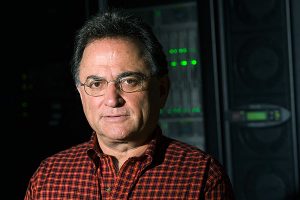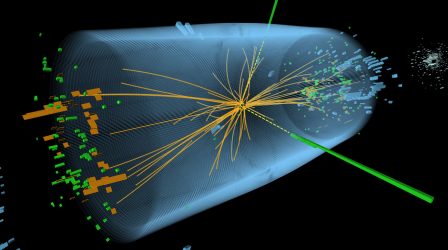In 1964, François Englert and Peter Higgs theorized the existence of a subatomic particle that gives all other particles mass. Nearly 50 years later in 2012, a global team of researchers found evidence that supports the existence of the Higgs boson particle at the Large Hadron Collider (LHC) in Geneva, Switzerland.
This week, the duo received the 2013 Nobel Prize in Physics, a point of pride for the hard-working network of scientists around the world focused on the project, including a group from UW–Madison.
Wesley Smith, a Bjorn Wiik Professor of Physics, and San Lan Wu, an Enrico Fermi Professor of Physics, led research teams in search for the particle, while Miron Livny, a professor of computer sciences and principal investigator of the Open Science Grid (OSG), helped create the computing technologies and infrastructure to store and process the data produced by the LHC.
Livny, who also leads the Core Computational Technology area of WID and the Morgridge Institute for Research, weighed in on the news from Geneva and commented on the impact of the LHC experience on global collaboration.

The Higgs discovery rests on years of work from people in different disciplines. How did your contribution play a role?
Miron Livny: Computing is a central part of this discovery. It’s a very large amount of data that’s being collected and analyzed. To give you a ballpark, the U.S. contribution that we run, the Open Science Grid, provides about one third of the total effort of the project, with more than 100 sites that offer the U.S. LHC effort around 1 million compute hours and move almost a petabyte of data per day. It’s a significant amount of computing that is happening on computers that are scattered throughout the nation.
The HTCondor software developed at UW–Madison also plays an important role in all of this. It has been adopted widely because the kind of computing that is needed for this science is very well aligned with what we have pioneered with our High Throughput Computing work. You want to make the science as efficient as possible.
Why do experiments at the collider create so much data?
It’s like if you take a watch and smash it with a hammer, breaking it into small pieces and then figuring out what goes together and works. It’s the same principle — they take multiple protons in the collider and collide them. These collisions are called events. You have to make many such events in order to find what you’re looking for.
They’re looking for very rare events in a huge collection. From when the collider opened in 2008 until 2012, there were a million billion events created, with about 4.2 billion of them analyzed. Finding evidence of the Higgs particle is much like finding a needle in a haystack. Our role is developing the technologies and creating the infrastructure that enables the physicists to handle the volume of data in a dependable and sustainable way.
A project of this scale requires collaboration. What can be learned from working with people in different fields?
I think this collaboration embraces the spirit of UW–Madison. It’s unique in the sense that we have members of two of the experiments and another in computing on the same campus. The larger idea we support is about sharing and working together to solve a big problem.
“What’s worth celebrating is the fact that someone came up with a theory, and the will of so many people dedicating their time made the discovery needed to verify that theory… For me, it’s a human story as much as it’s a science story.”
— Miron Livny
There were two people [Englert and Higgs] who developed the model and 5,000 to 6,000 scientists involved in the discovery process. It’s a tremendous celebration of an international effort that might not always be easy to see. Many people devote all of their careers to this. Our competition was our curiosity to find the Higgs boson, not each other.
Based on the Higgs finding, what insights can we gather about the future of science?
There are a lot of lessons we can try to learn from this as we’re trying in other fields to tackle similarly big problems. You’re moving from research from a single principal investigator to a team of 2,000 to 3,000 scientists and postdoctoral researchers. It’s nontrivial. You have to rethink how you work together, give credit and tenure, organize your efforts and promote a scientific endeavor among many people. We’re still learning how you create the system and framework for all these people to work together that leads to such a discovery.
We overlook these things but they’re fundamental, and we don’t do enough to study and understand them. What’s worth celebrating is the fact that someone came up with a theory, and the will of so many people dedicating their time made the discovery needed to verify that theory. Not many people have done this. For me, it’s a human story as much as it’s a science story.
—Interview conducted and edited by Marianne English


You must be logged in to post a comment.